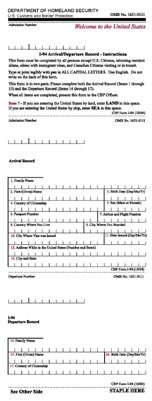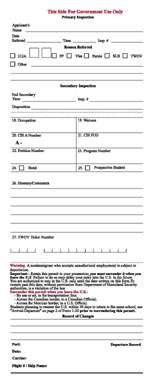Form I-94
An I-94 is a form denoting the Arrival-Departure Record of particular aliens used by U.S. Customs and Border Protection (CBP). U.S. Citizenship and Immigration Services (USCIS) uses Form I-94 also. Form I-94 must be completed at the time of entry to the United States by foreign citizens that are being admitted into the United States in a nonimmigrant visa status.[1] While citizens of the countries in the U.S. Visa Waiver Program (VWP) list,[2] who are entering the United States via an air or seaport for 90 days or less and who are not U.S. citizens or permanent residents are required to complete an I-94W ("Nonimmigrant Visa Waiver Arrival/Departure Form"), these visitors must now also obtain an Electronic System for Travel Authorization (ESTA) prior to traveling to the United States. The I-94W form requirement has been dropped during Summer 2010, after a transitional period, for VWP applicants.[3][4]
A completed Form I-94 is presented by the foreign citizen at the port of entry to the United States to a CBP Officer, who stamps the form and gives the final approval for admission of the alien into the United States in a specific nonimmigrant status for a specific authorized period.[5]
As a general rule, aliens who are not U.S. permanent residents[1] departing the United States are required to surrender their Form I-94 when leaving the United States, so that their departure can be properly recorded by the CBP Officers (typically to the airline or ship representative, or into a deposit box in the terminal). If the Departure Record portion is not surrendered then it may cause difficulties trying to re-enter the USA, as the systems used to track ingoing and outgoing visitors may show that the holder has overstayed, although this may be rectified.[6]
When departing the United States for Canada or Mexico, for a trip of less than 30 days, it is not required to surrender the I-94 [7] If the I-94 form is lost or stolen while the nonimmigrant is in the United States, a replacement form may be requested from USCIS.[8]
While in the United States, non-immigrant visitors[9] may apply for a change of non-immigrant visa status from one category to another or for an extension of the previous non-immigrant status by filing form Form I-539 with USCIS. Upon approving such application, USCIS issues an approval notice, the bottom portion of which is a new Form I-94 for the non-immigrant, reflecting that visitor's new or extended non-immigrant visa status and also showing a new authorization period for that status.
The I-94 paper form is no longer issued for international visitors arriving by sea or by air. Instead, arrival and departure information is gathered electronically from carriers. This system shift went into effect at five airports (Charlotte, Chicago, Las Vegas, Miami, and Orlando) on April 30, 2013, and progressively introduced at other major ports of entry during the following three weeks until it went nationwide.[10] Customs and Border Protection launched a new webpage on May 1, 2014, that offers nonimmigrant U.S. visitors access to their I-94 arrival/departure record and their arrival/departure history. The CBP webpage allows nonimmigrant travelers to access arrival/departure records going back five years from the request date. This electronic travel-history function means that travelers may no longer need to file Freedom of Information Act requests to receive their arrival/departure history, greatly speeding their process. Travelers will have electronic access to the date and port of entry of their arrivals and departures.[11]
See also
- Form I-539
- Electronic System for Travel Authorization
- Visa Waiver Program
- Automatic visa revalidation
References
- 1 2 "Filling Out Arrival-Departure Record, CBP Form I-94, for Nonimmigrant Visitors with a Visa for the U.S.". U.S. Customs and Border Protection. 2010-07-02. Retrieved 2010-09-27.
- ↑ "Visa Waiver Program (VWP)". U.S. State Department. Retrieved 2010-09-27.
- ↑ "DHS Reminds Visa Waiver Program Travelers of ESTA Requirements Effective Today" (Press release). Department of Homeland Security. 2009-01-12. Retrieved 2010-09-27.
- ↑ "Automated Processing for VWP Applicants".
- ↑ "FAQs on the Arrival-Departure Record (I-94 Form) & Crewman Landing Permit (I-95 Form)". U.S. Customs and Border Protection. 2008-12-31. Retrieved 2010-09-27.
- ↑ "How to record departure from the United States after the fact". U.S. Customs and Border Protection. 2010-06-05. Retrieved 2010-09-27.
- ↑ "Traveling to other countries while in the U.S. on a B1 or B2 visa". USCIS. Retrieved 2011-11-28.
- ↑ "Application for Replacement/Initial Nonimmigrant Arrival-Departure Document". USCIS. Retrieved 2010-09-27.
- ↑ "Non Immigrant Visa Denials: 10 Mind Boggling Facts!". Harlan York. Retrieved 2015-08-05.
- ↑ "Archived copy". Archived from the original on 2013-09-02. Retrieved 2013-04-12.
- ↑ http://www.cbp.gov/newsroom/spotlights/2014-04-30-000000/arrivaldeparture-history-now-available-i-94-webpage
External links
- U.S. Customs and Border Protection: I-94 Instructions
- U.S. Customs and Border Protection: Filling Out Form I-94
- U.S. Customs and Border Protection: FAQs on the Arrival-Departure Record (I-94 Form) & Crewman Landing Permit (I-95 Form)
- "DHS Reminds Visa Waiver Program Travelers of ESTA Requirements Effective Today", United States Department of Homeland Security, Office of the Press Secretary, January 12, 2009
- "Travel: Arrival-Departure Record"
- "How to record departure from the United States after the fact"
- Announcement from CBP of the new Paperless I-94 and the enforcing airports and ports' schedule
- Description, Fact Sheet and Q&A of new paperless I-94 Form
- New Immigration I-94 Arrival/Departure Record Card Automation Summary and Best Practices
- U.S. I-94 Admission Number Retrieval

